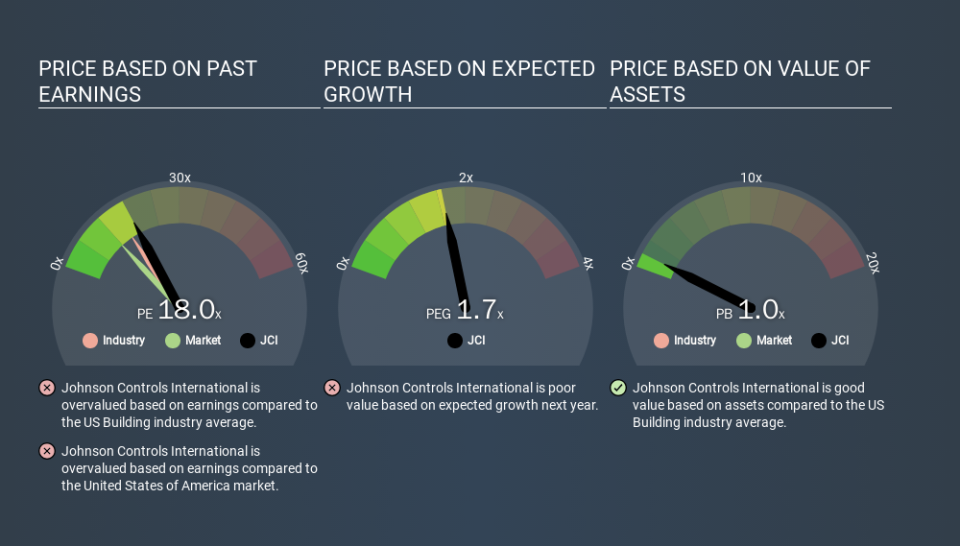How Does Johnson Controls International's (NYSE:JCI) P/E Compare To Its Industry, After The Share Price Drop?

To the annoyance of some shareholders, Johnson Controls International (NYSE:JCI) shares are down a considerable 41% in the last month. That drop has capped off a tough year for shareholders, with the share price down 31% in that time.
All else being equal, a share price drop should make a stock more attractive to potential investors. In the long term, share prices tend to follow earnings per share, but in the short term prices bounce around in response to short term factors (which are not always obvious). So, on certain occasions, long term focussed investors try to take advantage of pessimistic expectations to buy shares at a better price. Perhaps the simplest way to get a read on investors' expectations of a business is to look at its Price to Earnings Ratio (PE Ratio). A high P/E ratio means that investors have a high expectation about future growth, while a low P/E ratio means they have low expectations about future growth.
See our latest analysis for Johnson Controls International
How Does Johnson Controls International's P/E Ratio Compare To Its Peers?
Johnson Controls International's P/E of 18.00 indicates some degree of optimism towards the stock. The image below shows that Johnson Controls International has a higher P/E than the average (15.5) P/E for companies in the building industry.
Its relatively high P/E ratio indicates that Johnson Controls International shareholders think it will perform better than other companies in its industry classification. The market is optimistic about the future, but that doesn't guarantee future growth. So investors should delve deeper. I like to check if company insiders have been buying or selling.
How Growth Rates Impact P/E Ratios
Generally speaking the rate of earnings growth has a profound impact on a company's P/E multiple. If earnings are growing quickly, then the 'E' in the equation will increase faster than it would otherwise. That means even if the current P/E is high, it will reduce over time if the share price stays flat. A lower P/E should indicate the stock is cheap relative to others -- and that may attract buyers.
Johnson Controls International shrunk earnings per share by 5.7% last year. But it has grown its earnings per share by 7.5% per year over the last three years. And over the longer term (5 years) earnings per share have decreased 8.7% annually. So you wouldn't expect a very high P/E.
Don't Forget: The P/E Does Not Account For Debt or Bank Deposits
One drawback of using a P/E ratio is that it considers market capitalization, but not the balance sheet. So it won't reflect the advantage of cash, or disadvantage of debt. In theory, a company can lower its future P/E ratio by using cash or debt to invest in growth.
Such expenditure might be good or bad, in the long term, but the point here is that the balance sheet is not reflected by this ratio.
Johnson Controls International's Balance Sheet
Johnson Controls International has net debt equal to 27% of its market cap. While it's worth keeping this in mind, it isn't a worry.
The Bottom Line On Johnson Controls International's P/E Ratio
Johnson Controls International's P/E is 18.0 which is above average (11.8) in its market. With a bit of debt, but a lack of recent growth, it's safe to say the market is expecting improved profit performance from the company, in the next few years. Given Johnson Controls International's P/E ratio has declined from 30.7 to 18.0 in the last month, we know for sure that the market is significantly less confident about the business today, than it was back then. For those who prefer to invest with the flow of momentum, that might be a bad sign, but for a contrarian, it may signal opportunity.
Investors have an opportunity when market expectations about a stock are wrong. People often underestimate remarkable growth -- so investors can make money when fast growth is not fully appreciated. So this free report on the analyst consensus forecasts could help you make a master move on this stock.
But note: Johnson Controls International may not be the best stock to buy. So take a peek at this free list of interesting companies with strong recent earnings growth (and a P/E ratio below 20).
If you spot an error that warrants correction, please contact the editor at editorial-team@simplywallst.com. This article by Simply Wall St is general in nature. It does not constitute a recommendation to buy or sell any stock, and does not take account of your objectives, or your financial situation. Simply Wall St has no position in the stocks mentioned.
We aim to bring you long-term focused research analysis driven by fundamental data. Note that our analysis may not factor in the latest price-sensitive company announcements or qualitative material. Thank you for reading.

 Yahoo Finance
Yahoo Finance 
